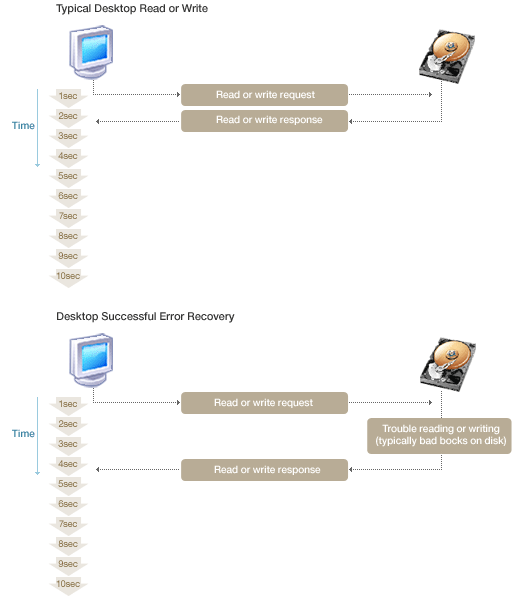Here's why it's important to use HDD with Time Limited Error Recovery (TLER) / Error Recovery Control (ERC) in RAID volumes. When the disk have problem with reading some sector it stop responding to the controller and if the raid controller didn't hear the disk for specific time the entire disk is ejected from the raid. The server disks have TLER set to < 7sec which limit the time that the disk spend of trying to read/write to the sector before reporting an error back to the controller and reallocate that sector.
I have a normal standard desktop disk without ERC which recently get ejected from Raid volume due to problems with some sectors.
The SMART status of the disk show some pending sectors:

When i run the SHORT smart test it also fail with the following error:
To force those pending sector to be reallocated i needed to write some data to them and without knowing exact LBA i decide to fill the entire disk using dd (destroy all data):
After that i run again SMART Long test which this time completed w/o error
Then I check again the SMART status to see if those sectors are reallocated or fixed:
After that i run some benchmark test using bonnie++ with gnuplot and spot unusual drop of the read/write speed at one zone around 1.6TB offset.
Performing read/write test (destroy all data on the disk) on each 2th 512MB block (skip=2) and saving result into csv file
Generating the chart from both csv files using gnuplot-lite into svg file

For comparison here's another 500GB disk:

After some research i found that this is due to sector slipping which is very well explained here:
 blog.stuffedcow.net
blog.stuffedcow.net
Here's a good example for the TLER/ERC.

 www.smallnetbuilder.com
www.smallnetbuilder.com
Some desktop (non-server) disks also support TLER which can be turned on using smartctl or wdtler / seatools.
I have a normal standard desktop disk without ERC which recently get ejected from Raid volume due to problems with some sectors.
The SMART status of the disk show some pending sectors:
When i run the SHORT smart test it also fail with the following error:
Code:
Num Test_Description Status Remaining LifeTime(hours) LBA_of_first_error
# 1 Extended offline Completed: read failure 90% 565 3240083936
# 2 Extended offline Completed: read failure 90% 432 3240083936
# 3 Short offline Completed: read failure 90% 432 3240083936
# 4 Short offline Completed: read failure 90% 432 3240083936
# 5 Conveyance offline Completed: read failure 90% 432 3240083936
# 6 Conveyance offline Completed: read failure 90% 432 3240083936To force those pending sector to be reallocated i needed to write some data to them and without knowing exact LBA i decide to fill the entire disk using dd (destroy all data):
dd if=/dev/zero of=/dev/ada0 bs=1MAfter that i run again SMART Long test which this time completed w/o error
smartctl -t long /dev/ada0
Code:
smartctl -l selftest /dev/ada0
smartctl 7.4 2023-08-01 r5530 [FreeBSD 14.1-RELEASE amd64] (local build)
Copyright (C) 2002-23, Bruce Allen, Christian Franke, www.smartmontools.org
=== START OF READ SMART DATA SECTION ===
SMART Self-test log structure revision number 1
Num Test_Description Status Remaining LifeTime(hours) LBA_of_first_error
# 1 Extended offline Completed without error 00% 587 -
# 2 Extended offline Completed: read failure 90% 565 3240083936
# 3 Extended offline Completed: read failure 90% 432 3240083936
# 4 Short offline Completed: read failure 90% 432 3240083936
# 5 Short offline Completed: read failure 90% 432 3240083936
# 6 Conveyance offline Completed: read failure 90% 432 3240083936
# 7 Conveyance offline Completed: read failure 90% 432 3240083936
6 of 6 failed self-tests are outdated by newer successful extended offline self-test # 1Then I check again the SMART status to see if those sectors are reallocated or fixed:
smartctl -a /dev/ada0
Code:
SMART Attributes Data Structure revision number: 10
Vendor Specific SMART Attributes with Thresholds:
ID# ATTRIBUTE_NAME FLAG VALUE WORST THRESH TYPE UPDATED WHEN_FAILED RAW_VALUE
1 Raw_Read_Error_Rate 0x000f 117 099 006 Pre-fail Always - 127067600
3 Spin_Up_Time 0x0003 096 096 000 Pre-fail Always - 0
4 Start_Stop_Count 0x0032 100 100 020 Old_age Always - 68
5 Reallocated_Sector_Ct 0x0033 100 100 010 Pre-fail Always - 0
7 Seek_Error_Rate 0x000f 089 060 030 Pre-fail Always - 933763960
9 Power_On_Hours 0x0032 100 011 000 Old_age Always - 598
10 Spin_Retry_Count 0x0013 100 100 097 Pre-fail Always - 0
12 Power_Cycle_Count 0x0032 100 100 020 Old_age Always - 59
183 Runtime_Bad_Block 0x0032 100 100 000 Old_age Always - 0
184 End-to-End_Error 0x0032 100 100 099 Old_age Always - 0
187 Reported_Uncorrect 0x0032 070 070 000 Old_age Always - 30
188 Command_Timeout 0x0032 100 099 000 Old_age Always - 2 2 2
189 High_Fly_Writes 0x003a 067 067 000 Old_age Always - 33
190 Airflow_Temperature_Cel 0x0022 077 058 045 Old_age Always - 23 (Min/Max 22/23)
191 G-Sense_Error_Rate 0x0032 100 100 000 Old_age Always - 0
192 Power-Off_Retract_Count 0x0032 100 100 000 Old_age Always - 21
193 Load_Cycle_Count 0x0032 100 100 000 Old_age Always - 966
194 Temperature_Celsius 0x0022 023 042 000 Old_age Always - 23 (0 13 0 0 0)
197 Current_Pending_Sector 0x0012 100 100 000 Old_age Always - 0
198 Offline_Uncorrectable 0x0010 100 100 000 Old_age Offline - 0
199 UDMA_CRC_Error_Count 0x003e 200 200 000 Old_age Always - 0
240 Head_Flying_Hours 0x0000 100 253 000 Old_age Offline - 78728h+02m+03.167s
241 Total_LBAs_Written 0x0000 100 253 000 Old_age Offline - 565858594670
242 Total_LBAs_Read 0x0000 100 253 000 Old_age Offline - 913997112022After that i run some benchmark test using bonnie++ with gnuplot and spot unusual drop of the read/write speed at one zone around 1.6TB offset.
Performing read/write test (destroy all data on the disk) on each 2th 512MB block (skip=2) and saving result into csv file
zcav -w -s 2 -f /dev/ada0 > ST2000DM001-write-512M.csv
zcav -s 2 -f /dev/ada0 > ST2000DM001-read-512M.csv
Generating the chart from both csv files using gnuplot-lite into svg file
set title "Disk throughput"
set xlabel "Offset GB"
set ylabel "MB/s"
set grid
set terminal svg
set output "plot.svg"
set multiplot
set object 1 rect from 1050,84 to 100,155 fc rgb "white" fillstyle solid noborder
plot "ST2000DM001-write-521M.csv" w lines lt 7 title "ST2000DM001 write", \
"ST2000DM001-read-521M.csv" w lines lt 10 title "ST2000DM001 read"
set origin 0.1, 0.15
set size 0.5, 0.4
set xrange [1590:1690]
set yrange [115:135]
unset title
unset xlabel
unset ylabel
unset grid
plot "ST2000DM001-write-521M.csv" w lines lt 7 notitle , \
"ST2000DM001-read-521M.csv" w lines lt 10notitle
unset multiplot
For comparison here's another 500GB disk:
set title "Disk throughput"
set xlabel "Offset GB"
set ylabel "MB/s"
set grid
set terminal svg
set output "plot2.svg"
plot "ST500DM002-write-512M.csv" w lines lt 7 title "ST500DM002 write", \
"ST500DM002-read-512M.csv" w lines lt 10 title "ST500DM002 read"
After some research i found that this is due to sector slipping which is very well explained here:
Discovering Hard Disk Physical Geometry through Microbenchmarking « Blog
Here's a good example for the TLER/ERC.

Should You Use TLER Drives In Your RAID NAS? - SmallNetBuilder
http://forums.smallnetbuilder.com/showthread.php?p=21166
 www.smallnetbuilder.com
www.smallnetbuilder.com
Some desktop (non-server) disks also support TLER which can be turned on using smartctl or wdtler / seatools.
